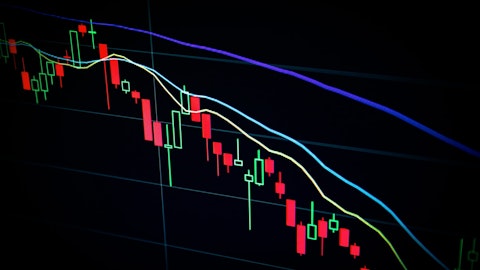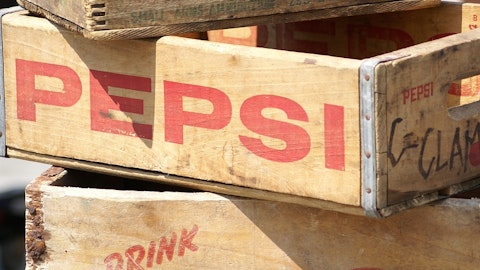The Coca-Cola Company (NYSE:KO) Q3 2023 Earnings Call Transcript October 24, 2023
The Coca-Cola Company beats earnings expectations. Reported EPS is $0.74, expectations were $0.69.
Operator: At this time, I’d like to welcome everyone to The Coca-Cola Company’s Third Quarter 2023 Earnings Results Conference Call. Today’s call is being recorded. If you have any objections, please disconnect at this time. [Operator Instructions] I would like to remind everyone that the purpose of this conference is to talk with investors and therefore, questions from the media will not be addressed. Media participants should contact Coca-Cola’s Media Relations department if they have any questions. I would now like to introduce Ms. Robin Halpern, Vice President and Head of Investor Relations. Ms. Halpern, you may now begin.
Robin Halpern: Good morning and thank you for joining us. I’m here with James Quincey, our Chairman and Chief Executive Officer; and John Murphy, our President and Chief Financial Officer. We’ve posted schedules under financial information in the Investors section of our company website at coca-colacompany.com. These schedules reconcile certain non-GAAP financial measures which may be referred to by our senior executives during this morning’s discussion to our results as reported under generally accepted accounting principles. You can also find schedules in the same section of our website that provide an analysis of our growth and operating margins. In addition, this call may contain forward-looking statements, including statements concerning long-term earnings objectives which should be considered in conjunction with cautionary statements contained in our earnings release and in the company’s periodic SEC reports.

A close up of a glass of a refreshing carbonated beverage illustrating the company’s different beverages. Editorial photo for a financial news article. 8k. –ar 16:9
Following prepared remarks, we will turn the call over for questions. Please limit yourself to one question. If you have more than one, please ask your most pressing question first and then re-enter the queue. Now, I’ll turn the call over to James.
James Quincey: Thanks, Robin and good morning, everyone. In the third quarter, we delivered strong top line growth, comparable operating margin expansion and earnings per share growth. Our strategy is working. These results continue our track record of consistent delivery. And given our year-to-date performance, we are raising both our top line and bottom line guidance. This morning, I’ll provide a brief update on the global consumer landscape. Then I’ll focus much of my time on business performance across the segments and discuss how we’ve been investing to further strengthen our capabilities to capture longer-term growth opportunities. John will end by discussing financial details for the quarter, our revised guidance for full year 2023 and some early considerations for 2024.
The global operating environment is always dynamic and this quarter was no exception. Some markets improved sequentially, while others dealt with a variety of factors ranging from transitory weather conditions, ongoing inflationary pressures, geopolitical tensions and conflicts. We delivered 11% organic revenue growth this quarter driven by positive volume, some pricing actions in the marketplace and carryover pricing coming into the base from last year. Volume grew 2% and sequentially improved each month in the quarter with September being our strongest month. Our year-to-date volume growth remains consistent with underlying performance compared to 2019. And overall, our industry remains vibrant and is expanding and we are executing to capture that growth.
During the quarter, we gained volume and value share in both at-home and away-from-home channels. Consumer sentiment continues to vary around the world. In developed markets, consumer spending in agro goods [ph] has held up quite well, however, some consumers feel pressured. We’ve seen some shift to discount channels and switching to private label brands in a few markets and categories. The intensity of this activity was largely the same across Europe compared to the previous quarter but was less pronounced in the U.S., Australia and Japan. In the developing and emerging markets, the picture is more mixed. We’re seeing broadly consumer strength across Latin America, India and in parts of Central and Southeast Asia. On the other hand, consumer confidence in spending has yet to fully recover in Africa and China.
Our revenue growth management execution capabilities give us a distinct advantage and we are leveraging these capabilities to ensure we have the right product in the right package in the right channel and at the right price points to meet consumers where they are. Notwithstanding the dynamics in play around the world, we have many levers to pull and continue to deliver through varying market conditions. I’ll share some more details from each region. Starting with Asia Pacific; we delivered organic revenue growth but operating income declined primarily as a result of investing ahead of the curve to participate in longer-term opportunities and incurring additional costs from strategic portfolio rationalization. In ASEAN and South Pacific, we grew top line and profit by linking our brands to drinking occasions coupled with strong execution.
In Thailand, we launched Coke Kitchen which connected consumers to influencers who shared their favorite recipes with Coca-Cola. We also partnered with food service aggregators to drive combo meals. Campaign attracted nearly 1 million consumers and we significantly increased the attachment rate of our beverages with meals ordered through food service aggregators. In Japan, we’re gaining volume and value share year-to-date. We continue to see strong momentum from our Coca-Cola, Georgia Coffee and I LOHAS campaigns and have stepped up execution in vending, e-commerce and community channels. However, in China, volume declined as the sparkling soft drink category is taking longer to recover. Our results were also impacted by some strategic conditions to deprioritize lower profit categories.
Our focus is to restore momentum to the sparkling soft drink category and capitalize on revenue growth management and execution opportunities. In India, we delivered double-digit volume and top line growth which resulted in the highest value share gain over the past 3 years. We’re winning in the marketplace by generating 2.6 billion transactions at affordable price point and driving availability across rural regions. Across Asia Pacific, as part of our World Without Waste strategy to help drive circular economy for packaging materials, our system launched 100% recycled PET packaging in India, Indonesia and Thailand. Moving on to EMEA; we delivered strong organic revenue and operating income growth. In Africa, macro conditions remain challenging and our business was further impacted by natural disasters in Morocco and Libya.
Despite this environment, we drove transaction growth through accelerated refillable PET expansion, digitizing nearly 100,000 outlets and adding 80,000 coolers used to date. In Europe, consumers are still facing pressure and our business was unfavorably impacted by poor weather. Despite these dynamics, we gained value share through strong performances in sparkling soft drinks and tea. We did this by partnering with systems to drive value for key customers and our consumers. We continue to see promising early results for Jack Daniel’s and Coca-Cola in Europe. We are learning and expanding in alcoholic drinks, including our recent announcement of our Absolut Vodka & Sprite. And last, in Eurasia and Middle East, we recruited consumers through innovative, occasion-based marketing events like Fanta Fest Turkey which focused on snacking occasions with concerts by prominent local artists.
They also launched 100% recycled PET package this summer. In North America, we generated strong organic revenue growth and delivered margin expansion by executing across our total beverage portfolio. We continue to see away-from-home channel outperform at-home channels. Within sparkling soft drink, elasticities are holding up well and we continue to drive quality leadership with Coca-Cola, Sprite and Fanta. For example, our systems stepped up in-store activation on Sprite Lymonade Legacy and with increased displays at point of sale which drove higher household penetration and repeat purchases. Fanta drove nearly 2 points of vale share gain year-to-date through innovation and new graphics, including the latest Halloween iteration of the What the Fanta platform.
Outside sparkling, BODYARMOR and Powerade trends are stabilizing. And fairlife, Core Power, smartwater and Gold Peak generated value share gains. And in the U.S., to protect water resources, we renewed a decade-long partnership with the Department of Agriculture to restore and improve water sheds in national forests and grasslands. Water is a critical priority for our system and the communities that we serve. In Latin America, we generated double-digit top line and profit growth by executing on all facets of our strategy which resulted in value share gains in 4 of our top 5 markets. In the fifth market, Mexico, we’re seeing improving value share trends over the last few months. We’re increasingly linking our brands to consumers’ passion points to build deeper connections.
In Brazil, through Coke Studio, we partnered with the Town Music Festival, where we hosted 60 hours of concert and engaged with artists and influencers which generated 1 billion impressions and reached nearly 50 million consumers. We continue to drive affordability through refillable packaging of larger PET packages. In developing and emerging markets, refillables are an important tool to eliminate waste and offer products at lower price points. Last, our systems stepped up availability, reflecting over 270,000 coolers year-to-date which increased our share of visible inventory in key areas. Global ventures generated strong overall growth. At Costa, we strengthened our revenue growth management equation while driving transaction growth. This was supported by strong innovation and marketing campaigns such as our global summer of ice, expansion of the refreshment category and the introduction of our personalized pre-drop loyalty activation in U.K. Additionally, innocent gained value share in both the U.K. and France.
Finally, Bottling Investments Group grew organic revenue and operating income through expanding affordable immediate consumption entry packs and progressing for strengthening route to market and optimizing trade collections. At the same time, we’re working towards decarbonizing our operations in India through using 200 electric vehicles with plans to add more before the end of 2023. Beyond the quarter, we continue to have confidence in the long term. We see momentum continuing across our industry and our system is galvanized more than ever to capture this opportunity. Leveraging data to drive better decision-making is key to improving execution. Our system has collectively invested in digital initiatives to drive on all facets of our strategy.
Starting first with marketing and innovation. Our marketing transformation is increasingly making our brands more relevant to consumers. Today, Gen Zs spend 7 to 9 hours per day on screen. However, very little time is spent watching traditional TV. We’ve been shifting our media spend towards digital. In 2019, digital was less than 30% of our total media spend and year-to-date is over 60%, through digital campaigns which segment the population that’s disproportionately reaching consumers where we earn higher return on investments. We’ve seen tremendous engagement through digital-first campaigns for Coke with meals, Sprite Heat Happens and Fuze Tea’s Made of Fusion among others. We’re taking bold steps to be at the forefront of both consumer and non-consumer facing generative AI.
For example, we launched Create Real Magic which turns consumers into digital creators. We also brought GenAI into our creative process for the award-winning Coca-Cola Masterpiece film and letting the fans the chance to take a piece of this work through the sale of NFTs. Recently, we launched Coke Y3000 which is our eighth iteration in the Coke Creations platform. Coca-Cola Y3000, the world’s first futuristic flavor, co-created with AI. The launch has demonstrated strong initial results. On the non-consumer facing side, we’re implementing generative AI to improve access to insight, market data, research and trends. Moving on to revenue growth management and integrated execution. As a system, we’re accelerating eB2B platforms that allow for better tailoring of product, price and packaging architecture, reducing out of stocks and optimizing placement of physical inventory.
Year-to-date, we’ve connected 6.9 million customers to eB2B platforms. We continue to expand coverage and offer customers personalization at scale. Initial pilots suggest that customers who receive AI-written push notifications have been more likely to purchase recommended SKUs, resulting in incremental retail sales. And we’re just scratching the surface of what’s possible but we’re investing in digital capabilities now to expand our potential down the road. To sum it all up, we’re encouraged by our results year-to-date and this is reflected in our updated 2023 guidance. We have many levers to pull and have proven that we can deliver in many types of markets around the world. We continue to win on a local level, maintain flexibility on a global level and reinvest to build our system for the long term.
With that, I’ll turn the call over to John.
John Murphy: Thank you, James and good morning, everyone. Today, I’ll comment on our third quarter performance and highlight our updated 2023 guidance. I’ll also provide some early commentary on 2024 and the actions we are taking to continue to deliver on our objectives. As James mentioned, we delivered strong third quarter results. Starting with the top line. We grew organic revenues 11%. Unit case growth was 2%. If you exclude the impact of suspending our business in Russia, we have delivered positive volume growth in each quarter since the start of 2021. Concentrate sales were in line with unit cases for the quarter. Price/mix growth was 9% driven by pricing actions across operating segments, including the impact of a few hyperinflationary markets, along with carryover pricing coming into the base from last year.
Comparable gross margin for the quarter was up approximately 130 basis points driven by underlying expansion and a slight benefit from bottler refranchising, partially offset by the impact of currency headwinds. Comparable operating margin expanded approximately 20 basis points for the quarter. This was primarily driven by strong top line growth and the impact of refranchising bottling operations, partially offset by an increase in marketing investments versus the prior year as well as currency headwinds. Putting it all together, third quarter comparable EPS of $0.74 was up 7% year-over-year despite higher-than-expected 4% currency headwinds. Free cash flow was approximately $7.9 billion year-to-date. This was largely attributable to strong underlying operational performance and working capital benefits, partially offset by $720 million transition tax payment and $230 million in M&A-related payments.
Our balance sheet is strong and our net debt leverage of 1.5x EBITDA is below our target range of 2 to 2.5x. Recently, we entered into a letter of intent to refranchise our Philippines bottler. As we progress on our refranchising journey, we aspire to improve the return profile of our business. In 2015, when Bottling Investments Group was more than 50% of our net revenue, our return on invested capital was approximately 17%. Today, Bottling Investments Group makes up less than 20% of net revenue. And our return on invested capital is over 23%, nearly a 7-point increase. After this transaction closes, our remaining assets in the Bottling Investments Group will include operations in India, Africa and several smaller locations, primarily in Asia Pacific.
We will remain disciplined in our refranchising approach by making sure we best position our system to deliver sustainable long-term growth. Our business performance year-to-date gives us confidence that we can deliver on our raised 2023 guidance. This is comprised of organic revenue growth of 10% to 11% which will be led by price/mix and includes positive volume growth. We do expect pricing in developed markets to moderate in the fourth quarter as we cycle pricing initiatives from the prior year. There are also a few hyperinflationary markets that will continue to drive price/mix. There will be 1 additional day in the fourth quarter. We now expect comparable currency-neutral earnings per share growth of 13% to 14%. And based on current rates and our hedge positions, we now expect currency to be an approximate 4-point headwind to comparable net revenues and an approximate 6-point currency headwind to comparable earnings per share for full year 2023.
Based on current rates and hedge positions, we continue to expect per-case commodity price inflation in the range of a mid-single-digit impact on comparable cost of goods sold in 2023. We now expect our underlying effective tax rate for 2023 to be 19%. All in, we are updating comparable earnings per share growth of 7% to 8% versus $2.48 in 2022. We continue to expect to generate approximately $9.5 billion of free cash flow in 2023 through approximately $11.4 billion in cash from operations. That’s approximately $1.9 billion in capital investments. This guidance does not include any payments related to our U.S. income tax dispute with the IRS which are unlikely to occur in 2023. Given the momentum of our business, the strength of our balance sheet and some proceeds that we expect to receive from bottler refranchising, we have increased flexibility to continue to both reinvest in our business and return capital to shareowners.
While it is too early to provide specific items on 2024, we want to share some considerations based on what we know today. We’re encouraged by our top line momentum across the majority of our markets. There are a handful of hyperinflationary markets where it is either not possible to hedge or it is costly to do so. In these markets, we’ve demonstrated that we can manage currency pressures by taking price with local market inflation and we will continue to follow this approach. While some commodities are normalizing, we also have input costs that could be impacted by tensions and conflicts. With respect to advertising spend, our bias is to continue to reinvest behind our brands while maintaining flexibility. Regarding currency, if we assume current rates and our hedge positions, there would be an approximate low single-digit currency headwind to comparable net revenues and an approximate mid-single-digit currency headwind to comparable earnings per share for full year 2024.
Of course, several factors could impact both our currency outlook and broader business outlook between now and February. Over the past few years, we’ve delivered U.S. dollar EPS growth and we have many levers to continue to do so. So in summary, we are encouraged by our business results and confident in our ability to deliver on our commitments over the long term. Thanks to the incredible commitment of our system employees around the world, we’re very clear on the direction we are heading and well equipped to execute on the strategies to get us there. And we continue to invest to drive sustainable long-term growth. We remain focused on capturing the opportunities available to us. With that, operator, we are ready to take questions.
See also 30 Dying Professions to Avoid Like a Plague and 30 Best Paying Jobs With High School Degrees.
Q&A Session
Follow Coca Cola Co (NYSE:KO)
Follow Coca Cola Co (NYSE:KO)
Operator: [Operator Instructions] Our first question comes from Dara Mohsenian from Morgan Stanley.
Dara Mohsenian: So clearly, another strong set of results in Q3 and obviously, increased confidence for the year with the full year raise. I’d love to sort of get a bit more perspective on 2024. I know you won’t want to put specific numbers around the outlook but was just hoping you can give us a sense for how you think about the pricing outlook for next year, given the strength in Q3 and perhaps break that down into the price increase versus mix versus hyperinflationary market pieces of it and what the competitive environment sort of portends for next year on the pricing front.
James Quincey: Let me just offer up a few thoughts, Dara. Firstly, just breaking out Q3 because I think that’s instructive as you think about the down end of the year and into next year. Firstly, there are a couple of points in Q3 that’s the carryover from the more inflationary environment from 2022. And obviously, that will drop out as we get into Q4 and obviously next year. And then you’ve got the regular pricing. And then you’ve got a couple of points of pricing that’s coming from these very high inflation markets, Argentina, Turkey and a number of the African markets that, given the levels of inflation, is making a difference at the overall company level. And as John mentioned in the FX guidance, we’re assuming some degree of negativity from those markets next year.
But we are assuming some degree of positivity in that sense in price/mix next year. The one thing that’s uncertain about — the one thing that’s certain about high inflation markets is it ends unpredictably. So it’s very early to have a full pitch on what that’s going to look like in 2024. And obviously, we’ll update when we get to February. So net-net, you’re going to have continued moderation heading towards the landing zone in the developed economies. You’ve got a couple of emerging markets which are subnormal inflation, aka China. And then, you’ve got a mixed bag of emerging markets and a particular importance is going to be what is the overall journey in these high-inflation marketplaces. So hopefully that provides some parameters with which to think about how it lands in Q4 and into next year.
Operator: Our next question comes from Lauren Lieberman from Barclays.
Lauren Lieberman: So one of the things that struck me as really interesting is in the release, when you specifically — first of all, it was helpful that you called out the specific contribution from inflationary pricing. But one thing I thought was interesting is the regions where there was greater inflationary pricing were also the regions where there was at least versus my expectations, better-than-expected unit case volume. So I think historically, right, the logic and the elasticity would say more pricing, less volume. But here, you’re getting that unit case volume to come through. So I just wonder if you could talk a little bit maybe about what you’re doing differently that’s enabling that kind of combination. And then also, if you’re able to speak to transaction growth in those markets also if that’s pacing — how that’s pacing relative to unit cases.
James Quincey: Sure. So firstly, I want to just underline that we have been pursuing for a good number of years but very specifically this year and also will be pursuing into next year is, no matter what the degree of inflation in the environment, we want to protect the scale of our consumer franchise and see it grow. In other words, we want to see positive volume or transaction growth in the environment. And so very much our strategy of the marketing, the innovation, the RGM, the execution has been very much around not just gaining value share in these environments but making sure that there’s volume growth embedded in it; so we very much take that approach. And as it relates to the regions where there was inflation, where there’s volume, I mean, the two biggest pieces of the puzzle are Latin America and EMEA.
And taking those in order, Latin America, the inflationary pricing is very clearly driven by Argentina. The rest of the content, generally speaking, is in the same sort of ballpark, the inflation that has been predominant there for an extended period of time. And it’s an environment we very much know how to operate in. And we have a great business there and they very much are masters of executing against the marketing innovation, the execution, the RGM. And then Argentina is a rollercoaster, given its inflation levels and its economic levels. I can say that from personal experience as I was the country manager there in 2001 and 2002 when they had a big devaluation and default on their debt. And so this is something where we know how to operate and it’s kind of part of what happens in certain markets in Latin America and so we are able to execute.
As it relates to EMEA, divided into two parts. One is the European environment where inflation, much like the U.S., is moderating down and the dynamic in Europe was much more around a moderating degree of inflation and the fact that they had a relatively poor summer in terms of the weather and the consumer is perhaps under a little more pressure than the U.S. The other half of the EMEA group is Eurasia and Africa. And in that context, there are a number of very high inflation marketplaces like Turkey, Zimbabwe as it happens, Nigeria to some extent, Egypt to some extent. And there, when the inflation does spike, you do occasionally see impacts to volume. But overall, we’ve been able to manage through it so that on a total segment basis, we’ve carried it through.
And we certainly look to, as I said, maintain and grow the consumer franchise, although in some of those markets in any given quarter, the volume may be negative as inflation tends to be much more spiky than the system.
Operator: Our next question comes from Bonnie Herzog from Goldman Sachs.
Bonnie Herzog: All right. I had a question on your marketing investments. They were up and, I guess, a drag on operating margins in the quarter; so just hoping for some more color on these reinvestments. And then, James, you mentioned your plans to continue to invest ahead of the curve. So could you provide a little more color on how you’re thinking about this? And then ultimately, how much of the top line strength you plan to reinvest in the marketing whether it’s this year? And then more importantly, how you’re thinking about this next year, especially in the context of greater FX headwinds. I guess trying to understand how flexible you’re going to be to balance these reinvestments with driving dollar EPS growth.
James Quincey: Okay. Just kind of let me try and unpack that a little bit. So we have come in post-COVID over the last couple of years and said we expected a rebound. And we are going to lean in and invest for growth as long as growth is there rather than trying to pull back in anticipation of something. And that modus operandi, I’m not sure I would characterize extra marketing as a drag on results, more as a motor to driving the top line and the bottom line that we’re seeing. So we feel that the leaning in is working, obviously, typified by the fact we’ve raised both the top line and the bottom line guidance. I think as a model to the extent that we can continue to push that through the end of this year and into next year, we would certainly be happy to do so.
Having said that, to the extent that 2024 brings some unexpected surprises, we will pivot, whether it’s a country, a region or globally, we will pivot with speed as we did in the second quarter of 2020 when COVID hit and we ramped down marketing spend in that environment. So we feel we’ve developed a much greater degree of flexibility to move, should moving be needed at whatever part of the world. But as a starting point, we’re going to lean in for growth. And I think the last thing I would say is if you think about the balance of all these items, if you take — if you kind of zoom out a little bit and take a broader perspective of the operating income margin because obviously, marketing is just a component of all the different pieces, if you take a look at operating income margin over the, I don’t know, last 5 years or so, you’ll see that it’s been increasing at about 0.5 point a year operating margin which is broadly in line with the implied leverage in the long-term growth model.





